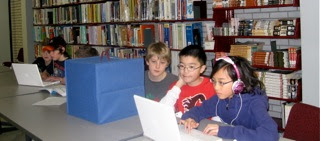What’s the difference between a school library and a school learning commons, and does the name make a difference? The Alberta School Library Association, which is informed by a larger Canadian and American field of school library studies, offers this:
Traditional school libraries are seen as quiet places full of printed books, people reading and librarians ‘shushing’. A Learning Commons takes school libraries into the 21st century. Yes, we still have printed text, and there are still people reading, and there is still a librarian, however the Learning Commons has so much more! There is a hum of activity with students talking, learning, searching for information on a variety of devices, focusing on content creation and synthesizing of information. The Learning Commons becomes the hub and the heart of the school; a place for teachers and teacher-librarians to collaborate to build inquiry learning and critical thinking skills in students; a place for technology integration and experimentation; a place that is ‘owned’ by students and staff alike.
The term learning commons recognizes that information, teaching and learning, and knowledge are collaborative in nature, and not confined within any walls, restricted to any format, nor rigidly scheduled. Like Calgary Science School, a learning commons has the doors wide open, and the lid off.
To me as a professional, a school library has never meant, “just books”- it has always been a gathering of resources, services and spaces for people, with a focus on teaching and learning (and I don’t think it has meant “shushing” for a very long time!). It reflects and supports the mission and vision of the learning community in which it lives.
Our library at CSS is a collaborative teaching and learning space, staffed with a qualified teacher-librarian and an experienced library assistant, is an integral part of the teaching and learning in the school. It is an open, bright and welcoming space at the centre of the school. The flexible scheduling welcomes students and teachers in classes, various groups, as well as individual students, during instructional and non-instructional times every day of the week. Areas within the library space accommodate small and large groups, independent and quiet activities, as well as brand new space called the collaboration centre (affectionately known as the “human aquarium”). This glass-walled enclosure is where teachers, students and parents can meet and plan while the rest of the room is being used for other activities. Our library does, of course, have shelves of books- nonfiction, fiction, reference, professional, audiovisual, and more- a collection which is undergoing constant change to reflect the digital world in which we live.
The library has always been considered an instructional space, which has helped define activities taking place within its walls. Students and teachers in the library may be engaged in collaborative learning activities in small and large groups, incorporating digital and real world sources of information, attending expert presentations, interacting in workshops by professionals, developing digital stories, selecting a book to read, writing and studying together, as well as independently- in other words, the library space, services, and resources all reflect and support the learning community of Calgary Science School.
While there are times you’ll find our library quiet and almost deserted, in most cases, (and I celebrate this) there will be the “…hum of activity with students talking, learning, searching for information on a variety of devices, focusing on content creation and synthesizing of information.”
Just like our understanding of what a classroom looks like, what the role of a teacher is, what learning means, the definition of school library has evolved. Whether we call it a learning commons or a school library may not be all that important. What is important, I think, is that when the literature on the learning commons is examined, our library, although still a work in progress, is moving in the right direction, and is indeed, “…a place… to collaborate to build inquiry learning and critical thinking skills in students; a place for technology integration and experimentation; a place that is ‘owned’ by students and staff alike.” We will continue to be informed by research in learning, which includes the learning commons, and for the time being, rather than changing the name, we need to continue to adjust our understanding of what a school library is, and maintain our direction of responding to, and supporting, the unique and dynamic teaching and learning happening everyday at the Calgary Science School.




2 comments:
Thanks for posting this! I would love to come and check out your learning commons sometime. I'm also planning a visit to Amy and Deidre's classroom so maybe we could connect then too. I am a learning leader in a NE CBE school. We have undergone the transformation from Library to Learning Commons. It's been an exciting journey. There has been a lot to learn! Our library also often has that 'hum' with students engaged in meaningful projects.
Donna, I appreciate the background information you provide in regard to the paradigm shift from library to Learning Commons. The photographs and descriptions of the multi-uses of the area are very informative. Through your blog you highlight how the transformation to Learning Commons has already taken place in the Calgary Science School.
Post a Comment